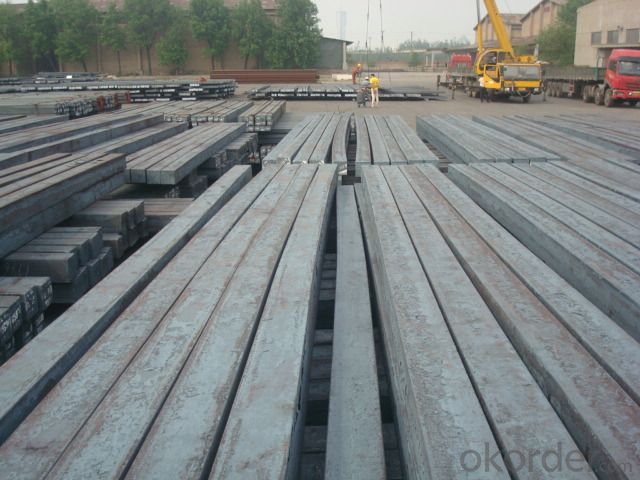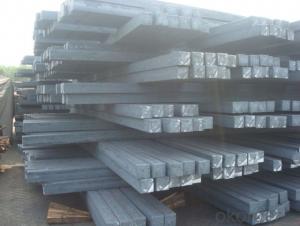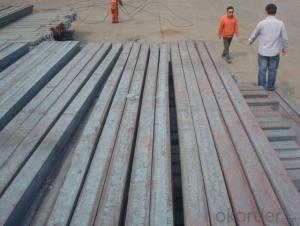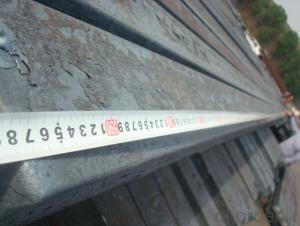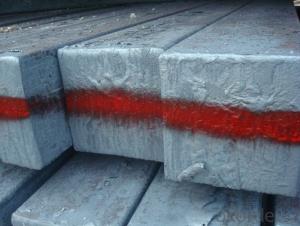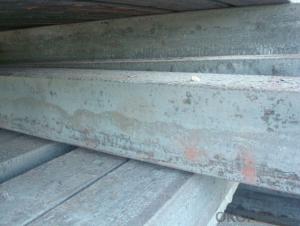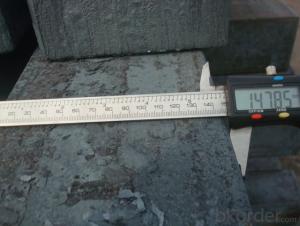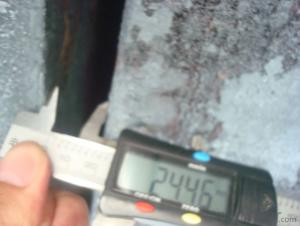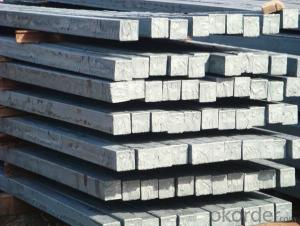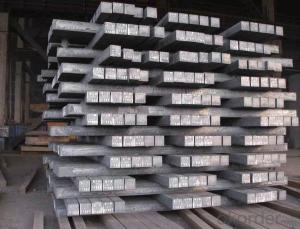Steel Billet/Bloom Made by Continue Casting Blast Furnace
- Loading Port:
- Tianjin
- Payment Terms:
- TT OR LC
- Min Order Qty:
- 1000 m.t.
- Supply Capability:
- 10000 m.t./month
OKorder Service Pledge
OKorder Financial Service
You Might Also Like
Steel Billet/Bloom Made by Continue Casting Blast Furnace
1.Structure of Steel Billet/Bloom Made by Continue Casting Blast Furnace
Steel Billet/Bloom Made by Continue Casting Blast Furnace is the raw material of all kinds of steel mill. Billet section of square, round, flat, rectangular and abnormity, etc Several, mainly related to shape of rolled products. Simple rolled section steel, choose cross section of square billet or rectangular billet. rolling The sector products such as flat steel, Angle steel, select the rectangular billet or slab. Had better profiled billet when production beams, channels, and in rolling process Lines and improve the yield. The raw material of round billet is the production of seamless tube.
2.Main Features of Steel Billet/Bloom Made by Continue Casting Blast Furnace.
Steel Billet/Bloom Made by Continue Casting Blast Furnace section size should meet the requirements of rolling deformation and finished product quality, but also roll strength and biting condition of restrictions. General steel Billet section height H. And the roll diameter D The ratio of the ( namely H/D) Should be less than or equal to zero 0.5 . Length of steel billet by finishing temperature, Rolling time and the length of the product Or times ruler. When heated too long accident prone to bump the furnace wall of steel, too short, furnace bottom utilization rate is not high, influence the heating furnace production. For the production Choose a variety of steel and steel billet, should consider the affinities of billet, as far as possible in order to improve the productivity of the roughing mill, simplify the stock management of workshop.
There are three shapes of the steel billets: square billet, slab, rectangular billet The Chinese billet, rectangular billet is mainly suitable for rolling hot rolled strip, building reinforced bar, Ordinary wire, high speed wire rod and various small profile. Of the slab are mainly used for rolling plate and hot coil sheet.
3. Steel Billet/Bloom Made by Continue Casting Blast FurnaceImages


4. Steel Billet/Bloom Made by Continue Casting Blast FurnaceSpecification
Steel Billet/Bloom Made by Continue Casting Blast FurnaceMaterial standard The editor Range of thickness: 150-240 - mm + / - 5 mm width range: 880-1530 - mm + / - 20 mm Length: 3700-10000 - mm + / - 500 - mm Cross-sectional size: 64 * 64; 82 * 82; 98 * 98; 124 * 124; 120 * 150; 152 * 164; 152 * 170 mm Length: 9000 mm Section of tolerance: billet: 1.0 + / - 2.0-1.0 + / - 1.0 mm slab: width: + / - 2.0 mm thickness: + / - 3.0 mm The length tolerance: + / - 200 mm Section diagonal tolerance: 3.5-8.0 MM Billet section size protrusions requirements: < 1242 mm, do not allow; > = 1242 mm, < = 2 mm 1242 mm, < = 3 mm Beheading (shear) extension deformation: < 1242 mm billet: no control; The slab: < = 15 mm Surface tilt: no more than billet section 0.1 Bending: every 1 m length is not more than 10 mm The distortion: length < = 5 m, < = 11. ; The length of the < = 7.5 M, < = 5. Material % 3 sp/PS chemical composition: C Mn Si S P
5.FAQ of Steel Billet/Bloom Made by Continue Casting Blast Furnace
We have organized several common questions for our clients,may help you sincerely:
①How about your company?
A world class manufacturer & supplier of castings forging in carbon steel and alloy steel,is one of the large-scale professional investment casting production bases in China,consisting of both casting foundry forging and machining factory. Annually more than 8000 tons Precision casting and forging parts are exported to markets in Europe,America and Japan. OEM casting and forging service available according to customer’s requirements.
②How to guarantee the quality of the products?
We have established the international advanced quality management system,every link from raw material to final product we have strict quality test;We resolutely put an end to unqualified products flowing into the market. At the same time, we will provide necessary follow-up service assurance.
③How do you determine the billet section size? Determination of billet section size in addition to considering the deformation of rolled piece to have enough quantity to meet the finished productThe quality requirements, but also should consider to roll strength and rolling bite into the limitations. The deformation size has a great influence on the product performance.Can make the metal internal organization and deformationPerformance can not meet the quality requirements.Such as high speed steel must have enough deformation,The carbide networkTo be broken or heavy rail and seamlessSteel pipeBy the total elongation coefficient of steel ingot to the finished product usually must alsoGuarantee up to50). However, in the roll diameter and reduction given conditions, if the blank section size is too big, not only canCan occur due to deformation of impervious surface deformation of rolled piece,But also roll breakage happens,biteEntering the rolled piece difficult, etc., generally billet height and roll diameter has the following relationship: The H/DOr less0.49 (4 to 5) Type in theH.- height of billet,mm; D- work roll diameter,mm. type4 to 5The data is given from the guarantee roll blank section strength and bite conditions decisionThe size of the important parameters. Ingot after the blooming mill rolling into or through forging press forging into different specifications of the billet,Are all kinds of finished product rolling millThe main raw material.Cross section shape of the billet (as shown in figure4-3) there are square, rectangular and circularAnd other shapes (alien). There is a wide variety of billet section shape is the root cause of steel varieties, specifications range is very wide,Profile is varied,And with the same cross section shape of all varieties of steel billet production isNot possible.
- Q: How are steel billets heated for rolling?
- To prepare steel billets for rolling, they undergo a process known as billet heating or billet reheating. This involves subjecting the billets to high temperatures, making them more malleable and easier to shape during rolling. Various methods can be used to heat steel billets for rolling. One commonly employed technique involves the utilization of a walking beam furnace. Here, the billets are positioned on a conveyor that moves them through a furnace. The furnace is heated to a specific temperature, typically ranging from 1100 to 1250 degrees Celsius, and the billets are exposed to this heat for a predetermined duration. Continuously moving the billets through the furnace ensures uniform heating. Another method for billet heating involves the use of a rotary hearth furnace. In this approach, the billets are placed on a rotating hearth, which is heated by burners located beneath it. As the billets rotate on the hearth, they gradually absorb the heat emitted by the burners, gradually reaching the desired temperature. Induction heating is also a popular option for billet heating. This method employs an induction coil to generate an alternating magnetic field. The billets are placed within the coil, and the magnetic field induces electrical currents within them, resulting in the billets heating up. Induction heating is renowned for its efficiency and precise temperature control. Once the steel billets attain the desired temperature, they are ready for the rolling process. The heated billets are then transferred to a rolling mill, where they undergo further processing and shaping into various forms, such as bars, rods, or sheets. The heating process is crucial, as it enhances the ductility of the steel billets, minimizing the risk of cracking or failure during rolling.
- Q: How are steel billets measured?
- Steel billets are measured using various techniques and tools to ensure accurate dimensions and specifications. One common method is through the use of calipers or micrometers. These tools allow for precise measurements of the billet's diameter, length, and any other required dimensions. In addition to physical measurements, steel billets may also undergo non-destructive testing methods such as ultrasonic testing or eddy current testing. These techniques can detect any internal defects or inconsistencies in the billet, ensuring its quality and integrity. Furthermore, steel billets are often weighed to determine their mass. This can be done using different weighing scales or load cells, depending on the size and weight of the billet. The weight measurement is crucial in determining the billet's mass per unit length, which is important for calculating its density and other mechanical properties. Overall, the measurement of steel billets is a crucial step in the manufacturing process, as it ensures that the billets meet the required specifications for further processing and usage in various industries such as construction, automotive, and manufacturing.
- Q: How can steel billets be recycled or reused?
- There are several ways to recycle and reuse steel billets. A common method involves melting down the billets and using the resulting molten steel to create new products. This process, known as remelting, allows for the steel to be utilized in a variety of applications. Another option is to incorporate the steel billets into the production of other steel products. For instance, they can be utilized to produce steel rods, pipes, or beams. By integrating the billets into the manufacturing process, the steel industry can minimize waste and decrease the necessity for extracting new raw materials. Construction projects can repurpose steel billets as well. They can serve as raw material for constructing structures like bridges, buildings, or highways. By using recycled steel billets, construction projects can lessen their environmental impact and contribute to a more sustainable future. Moreover, steel billets can be transformed into smaller components through processes like rolling or forging. These components can then be employed in various industries, including automotive, machinery, and infrastructure. By reusing steel billets in this manner, we can decrease the need for producing new materials and conserve resources. In summary, recycling and reusing steel billets offer numerous advantages, including waste reduction, resource conservation, and sustainability promotion. By implementing proper recycling and reuse practices, steel billets can have a second life in various industries, thus becoming a valuable resource in the circular economy.
- Q: How do steel billets contribute to the telecommunications industry?
- Steel billets are used in the telecommunications industry to manufacture various infrastructure components such as towers, poles, and cables. These components provide the necessary support and stability for the installation of telecommunication equipment, ensuring reliable and efficient communication networks. Steel billets contribute to the industry by providing the raw material needed for the production of these essential infrastructure components.
- Q: How are steel billets used in the production of agricultural equipment?
- The versatility and durability of steel billets make them indispensable in the production of agricultural equipment. These semi-finished steel products come in solid rectangular forms, making them perfect for various manufacturing processes. When it comes to agricultural equipment production, steel billets serve as the primary raw material for forging, casting, or rolling. Forging involves heating the billets to a specific temperature and shaping them with a hammer or press. This method is commonly used to create robust components like plowshares, tiller blades, and harrow teeth that require superior strength and resistance to wear. Casting, on the other hand, involves pouring molten steel into a mold and allowing it to solidify. By melting and casting steel billets into intricate shapes, manufacturers can produce complex components such as tractor engine blocks, combine harvester parts, and agricultural machinery frames. This flexibility in shape allows for customized equipment that meets specific requirements. Rolling is yet another technique that utilizes steel billets in agricultural equipment production. The billets are heated and then passed through rollers to reduce their size and shape them into bars, rods, or sheets. Rolled steel billets are commonly used for manufacturing axles, shafts, and brackets, which are crucial for the proper functioning of agricultural machinery. The inherent strength and durability of steel billets make them highly preferred in agricultural equipment production. The demanding conditions of the agricultural industry require machinery that can withstand harsh environments, heavy loads, and repetitive use. Steel billets offer exceptional strength, enabling the creation of equipment that can endure these challenging conditions. Furthermore, heat treatment processes like quenching and tempering can further enhance the mechanical properties of steel billets. In conclusion, steel billets play a crucial role in the production of agricultural equipment. Their versatility and durability allow manufacturers to create components and machinery that can withstand the challenging conditions of the agricultural industry. Whether used in forging, casting, or rolling, steel billets provide the necessary strength and reliability for efficient and long-lasting agricultural equipment.
- Q: What are the different surface treatments for improved surface cleanliness in steel billets?
- There are several surface treatments available for improving surface cleanliness in steel billets, including shot blasting, pickling, acid cleaning, and electrochemical cleaning. Shot blasting involves propelling abrasive particles onto the surface to remove scale, rust, and contaminants. Pickling involves immersing the billets in an acid solution to dissolve oxides and surface impurities. Acid cleaning uses chemical solutions to remove surface contaminants and oxides. Electrochemical cleaning utilizes an electric current to remove oxides and impurities from the surface. These treatments help ensure better surface cleanliness and prepare the steel billets for further processing or applications.
- Q: How are steel billets used in the manufacturing of medical devices?
- Steel billets are used in the manufacturing of medical devices as a raw material for shaping and forming various components. They are often melted down and poured into molds to create intricate shapes and designs required for medical devices such as surgical instruments, implants, and prosthetics. The high strength and durability of steel make it an ideal choice for ensuring the longevity and reliability of these devices, ensuring they can withstand the rigorous demands of medical applications.
- Q: Can steel billets be used in the production of jewelry?
- No, steel billets cannot be used in the production of jewelry. Jewelry is typically made from precious metals such as gold, silver, or platinum, which offer a higher level of aesthetic appeal and value. Steel, being an alloy primarily used in construction and manufacturing industries, lacks the desired characteristics and appearance required for jewelry production.
- Q: How do steel billets contribute to the manufacturing of sports equipment?
- The manufacturing of sports equipment benefits greatly from the use of steel billets. Firstly, steel billets serve as the primary material for the production of steel bars and rods. These bars and rods are then utilized to create the framework and structure of sports equipment, including golf clubs, tennis rackets, and hockey sticks. The exceptional strength and durability of steel make it the perfect material for these applications, as it can withstand the intense impact forces and stresses that occur during sports activities. Furthermore, steel billets are also employed in the manufacturing of various components for sports equipment, such as weights, dumbbells, and barbells. These components necessitate a material with high density that can handle heavy loads, and steel provides the necessary strength and stability. Additionally, steel billets find use in the production of accessories for sports equipment, such as ball bearings, springs, and fasteners. Despite their small size, these components play a vital role in the overall performance and functionality of sports equipment. Steel's exceptional resistance to corrosion and its ability to endure extreme conditions make it the preferred choice, ensuring long-lasting and reliable performance. Moreover, steel billets enable the production of high-quality and precision-made parts for sports equipment. Steel's malleability and formability allow it to be shaped into various intricate designs and configurations, guaranteeing that sports equipment meets the specific requirements of athletes and performs optimally. In conclusion, steel billets are a crucial element in the manufacturing of sports equipment. Their strength, durability, versatility, and formability make them the ideal material for producing frames, components, and accessories that enhance the performance and longevity of sports equipment.
- Q: What are the main challenges in manufacturing steel billets?
- There are several main challenges in manufacturing steel billets. One of the primary challenges is the need for high-quality raw materials. Steel billets are typically produced from scrap metal or iron ore, and ensuring that the raw materials meet the required specifications is crucial for producing high-quality billets. Contaminants in the raw materials can lead to defects in the final product, affecting its strength and performance. Another challenge is maintaining consistent and precise control over the manufacturing process. Steel billets need to be heated to a specific temperature and then cooled rapidly to achieve the desired metallurgical properties. This requires precise control of the heating and cooling rates, as well as the overall process parameters, such as time and pressure. Any deviations in these parameters can result in inconsistencies in the billets' properties, affecting their quality and suitability for various applications. Energy consumption is also a significant challenge in steel billet manufacturing. The process of heating and cooling the billets requires a significant amount of energy, contributing to high production costs and environmental impact. Finding ways to optimize energy usage and improve energy efficiency is a constant challenge for steel manufacturers. Furthermore, maintaining the equipment and machinery used in the production process is crucial. The high temperatures and harsh conditions in steel manufacturing can lead to wear and tear on the equipment, resulting in potential breakdowns and production delays. Regular maintenance and timely repairs are necessary to ensure smooth operations and minimize downtime. Safety is another vital challenge in steel billet manufacturing. The process involves handling heavy materials, high temperatures, and potentially hazardous chemicals. Implementing robust safety protocols, providing proper training to workers, and ensuring compliance with safety regulations are essential to create a safe working environment and prevent accidents or injuries. Lastly, market demand and competition pose challenges for steel billet manufacturers. The industry is highly competitive, and staying ahead requires continuous innovation, cost optimization, and the ability to adapt to changing market trends and demands. Meeting customer expectations, delivering on time, and maintaining high-quality standards are critical factors for success in the steel billet manufacturing industry.
Send your message to us
Steel Billet/Bloom Made by Continue Casting Blast Furnace
- Loading Port:
- Tianjin
- Payment Terms:
- TT OR LC
- Min Order Qty:
- 1000 m.t.
- Supply Capability:
- 10000 m.t./month
OKorder Service Pledge
OKorder Financial Service
Similar products
Hot products
Hot Searches
Related keywords



